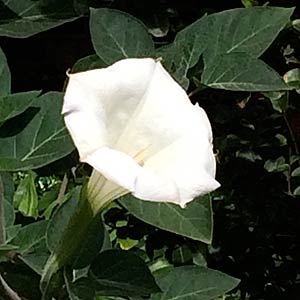
An excellent garden plant, Datura metel with its large upward facing trumpet shaped flowers is sure to be one of the more exotic plants in any garden.
Useful for its low growing habit and attractive foliage, Datura metel can be used as a feature plant in the border or mass planted as a bedding plant.
In warmer climates Datura metel will thrive, the flowers are perfumed and range from the single white of the species through to double flowering purple tinged specimens. Although Datura are often classifies as annuals, and sometimes perennials this will depend on the climate.
In warmer climates they are long lived perennials, however in cooler climates, extreme cold or a frost will be the end of them. One issue is self seeding, particularly in warmer areas, many gardeners choose to remove the spiky seed heads to prevent this.
Originally from China it is commonly called Horn of plenty and Thorn Apple. All parts of the plant are regarded as poisonous.
Care
Best planted in a protected frost free position in full sun, in warmer dry climates some protection from the hot afternoon sun is advisable. To much shade will inhibit flowering.
Datura metel can be grown in containers, if they are deadheaded you will encouraged repeat flowering over a few month from late spring through summer.
In colder climates Datura metel can be coaxed through the winter by cutting back hard and protecting from frost and cold by moving to a sheltered position, mulching or using a fleece to protect the plant. Good winter drainage and the avoidance of soil freeze is essential.
Propagation
From cuttings taken in spring or from seed sown in a cold frame.
Sow Datura metel seeds and cover lightly as they do need light to germinate.
You may also be interested in
- Brugmansia plants
- Brugmansia x candida Culebra
- Brugmansia and Datura Differences and Identification

